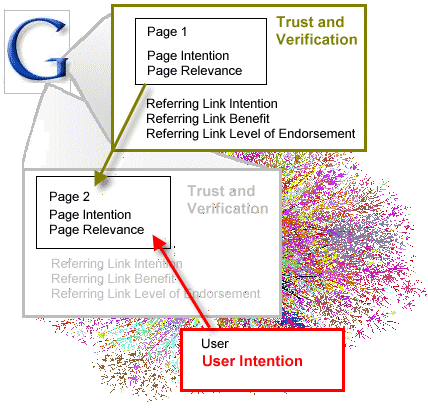How to fix what is broken and not break what is not
This post is part of a series. See Part 1, Part 2 and Part 4
“Jagger” and “BidDaddy” Aftermath
What came with the Jagger update [i] was something called “TrustRank [i]” and the “Google Sandbox Effect[ii]”. The “Sandbox” was a hot topic and many conflicting opinions exist. There were even debates if something like the sandbox exists, but in November 2005 did Matt Cuts admit[iii] in an interview at PubCon 2005 in Las Vegas that there are factors that could be interpreted as such an effect. To this day is it not exactly clear how the sandbox effect works and if there are ways around it or not.
Thoughts and Ideas
Something like the Google Sandbox Effect remain with us, if trust remains part of the equation what it should in my opinion. I hope though that the effect will become something that has not to do as much with time than with activity, meaning that a site with no activity remains in the sandbox for as long as there is no activity.
The current factors used by Google, such as domain age and link age are good and bad at the same time. It is bad, because it does penalize new sites too much for too long. I believe that it would help to extend “TrustRank” further and incorporate characteristics from real world Trust between people.
Trust in the Real World
It is like with people. You do not trust anybody you just have met. How quickly you trust somebody is less a time factor, but has to do with what the person is doing or is not doing and how much it does match what the person says about himself, his intentions and his plans.
You might build trust more quickly if somebody you already know and trust introduces you to a person.
Trust does not mean blind trust. It takes a lot to trust somebody that much that you would go “and steal horses together”, if he asks you to. Blind trust is most of the time founded in emotional reasons or lack of experience and intellect. There is no need by search engines to emulate this and apply a virtual equivalent in any form to search and search result ranking.
Don’t Trust Blindly and Forever
Even if it is somebody, you trust, trust for a short while or already for ages, can this trust get lost over night or at least severely damaged. Thinks like:
If you see a discrepancy, emerging between what he says and what he actually does, lies.
If what he says is matching what he does, but that it is in unacceptable conflict with what you consider good. Just being in conflict is not enough to lose your trust; it only means that you have different opinions about something. Only if that something is fundamental, does the break occur.
Real Word Trust Mechanisms Applied to Search
I think that it is important that search engines apply the mechanisms behind this human notion of establishing trust and reducing and eliminating it when necessary, in one form or another into their algorithms.
This trust is then used to evaluate what webmasters say themselves about their own content (on site factors) and to what they say about their links to other sites. You do not trust a notorious liar. You might only trust it a little, if others that proofed to be trustworthy back it up.
Webmasters have many ways to tell search engines (and people) about their intentions, plans and about themselves via the content on their own pages. They have virtually no way of doing the same for the links to other websites. Simply applying the on-page information to the link does not work in many cases. It could only work for links to pages that have the same intend and purpose as the linked-from pages.
Applying on-page Information to Links
Examples where it works
- link from one scientific research document to another about the same subject (reference, extended information)
- link from one product to another product that is complimentary or similar (cross sale, up sale)
Example where it does not work
- link from a news article to the source of the news
- link from a review page to a product
- link from a product to the specifications of the product or information about the manufacturer
- link from testimonials to anywhere than another testimonial
Just to name a few
Existing Link Attributes
The NOFOLLOW attribute is a signal to the search engines, but the attribute only allows extremes, ON or OFF and nothing in between. Multiple intentions could be the cause for the use of the attribute, which other webmasters as well as the search engines might misinterpret, if they start treating the NOFOLLOW attribute as a negative vote. Treating a link as a vote is wrong.
A link is primarily a pointer, also a reference. I wrote about this[iv] in detail in January already, but here is the conclusion of it. A link does not have to be an endorsement. It could be neural, like in cases where you do a citation and link to the source. It could also be a call to action against something.
Possibly “negative” attributes
(B) Personal Benefit: Low – High or 0 – 10, from Low (0) don’t see a dime, over (1-9) “I get commission/some sponsorship” to High (10) get paid a chunk of money for the location, target and anchor text of the link
(S) SEO Intention: Low – High or 0 – 10, from Low (0) “SEO, what? Google, who?” over (1-9) “it helps a bit with the SEs” to High (10) “SEO Baby, yeah”
Offset by this “positive” attribute
(E) Endorsement: Low – High or 0 – 10, from Low (0) “no endorsement/not reviewed yet (links added by others)” over (1-9) “It does not hurt to check out/advertising/good stuff” to High (10) “Love it. Best thing since sliced bread”
It could be extended to allow negative values (if a numeric scale is being used) to allow webmasters to express dislike or even warning. It is kind of a simplified form of a spam report. Something like this should not become part of the ranking algorithms, because of its high vulnerability against abuse and manipulation. It could become a useful tool to raise flags and trigger manual review and evaluation, which should not only result into bans if warranted, but manual adjustment of the Trust, if the automatically determined level of trust is too high.
And for relevancy
(I) Intentions Low – High or 0 – 10, from Low (0) “Informational” over (1-9) “branding, pre-selling and soft selling” to High (10) “Commercial, Selling”

Continue with Fixing Google Web 2.0 Style – Part 4 of 4
Carsten Cumbrowski
Cumbrowski.com – Internet Marketing Resources
[i] Rob Sullivan (5. December 2005), “Google Sandbox vs TrustRank Effect on SEO” and “Google SEO: Sandbox, TrustRank, Jagger Update“, SearchEngineJournal.com
[ii] “Sandbox Effect” article (The “Goggle Sandbox Effect”), Wikipedia.org
[iii] Barry Schwartz (17. November 2005) , “Matt Cutts Confirms Google Sandbox Exists“, SearchEngineJournal.com
[iv] Carsten Cumbrowski (7. January 2007), “A Link Is Not A Vote, It’s A Pointer”, SearchEngineJournal.com




